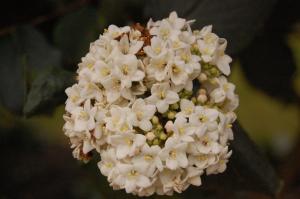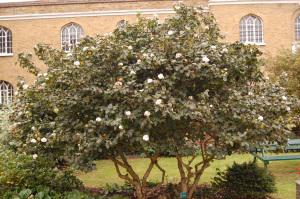
Viburnum x carlcephalum flower (16/10/2011, London)
Position: Full sun to partial shade
Flowering period: Spring to early summer (although this photo was taken in October)
Soil: Well Drained
Eventual Height: 3m
Eventual Spread: 3m
Hardiness: USDA Zones 6a – 8b
Family: Caprifoliaceae
Viburnum X carlcephalum is an open, deciduous shrub, with an upright spreading, bushy habit. It’s leaves are lightly fuzzy, oval shaped and have a sheen on their medium to dark green color. The leaves are rounded and turn an outstanding deep purple in autumn. The flowers are fragrant, white in colour, appearing at the ends of branches in spring to early summer, in the form of snowy balls, which emerge from distinctive pink flower buds before the leaves, on 5 inch somewhat irregularly shaped cymes. The flowers are produced in corymbs 5-15 centimeters across. Red to black fruit are produced in autumn, these are not terribly decorative.
V. X carlcephalum, commonly known as Fragrant Snowball. Selected in 1932, this hybrid plant originated in England at the Burkwood and Skipwith Nursery in Kingston on Thames. It is a result of a cross between a Korean spicebrush (Viburnum carlesii) and Chinese snowball Viburnum (Viburnum macrocephalum f. keteleeri)
The etymology of the binomial name Viburnum is derived from the classical Latin name for Wayfaring tree, Viburnum lantana. Carlcephalum is a hybrid of the names of the parents of this plant carlesii and macrocephalum.

Viburnum x carlcephalum (16/10/2011, London)
The landscape architect may find Viburnum X carlcephalum useful as a fragrant medium sized shrub. It may also be used as an informal hedging plant. It’s tolerance of urban pollution make it suitable for urban planting. Once established this plant is extremely drought tolerant.
Ecologically this plant is attractive to birds and butterflies.
Viburnum X carlcephalum has won the prestigious Royal Horticultural Societies annual Award of Garden Merit in 1993.
V. x carlcephalum will thrive in soils of most pH and is not particular to moisture content, although it will not grow in waterlogged soils.
Maintenance: This plant requires little maintenance. Pruning, if required, should be carried out after flowering.

